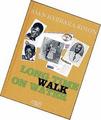
Title: Long Time Walk on Water
Author: Joan Barbara Simon
Publisher: Martin Schuz Creative
Reviewer: Barbara Nelson
"I would work 24 hours a day, walk a long long time on water if it mean my children can come over and get a good start in life," Emily 'Rose' Thompson writes to her friend Junie in Jamaica. Junie is taking care of her two children, Marlene and Leroy, while Rose is in 'Hingland', the Motherland.
Long Time Walk on Water, written by Joan Barbara Simon, is a depiction of the Caribbean immigrant experience in the United Kingdom (UK) in the early 1960s. The author, born in 1966 to parents from the West Indies, lives in France and teaches English at the University of Strasbourg.
Back in the summer of 1989, Simon had come to realise the sacrifices her grandmother made when she left her children in Jamaica and started a new life in England. The story, she says , is a "family fairy tale" and she asks the reader to "suspend your disbelief: do not go in search of strict adherence to the facts or chronology of life, least of al,l vis-a-vis my own, for the protagonists slip in and out of names like garments and time shifts like the plates of the earth".
Good advice
This is good advice, for it helps the reader to understand many of the peculiarities in the beautifully written 281-page novel.
Simon explains that her spelling of Jamaican (language) "is predominantly phonetically oriented, my model being the melodies of the language acquired at home, thus the experience gained by ear, buttressed by the Dictionary of Jamaican English (1985), edited by FG Cassidy and RB Le Page". She seeks to transmit something of the wonderful dialect and does so very well.
There are several characters in the book, all clearly drawn and well defined. The author writes with clarity, pathos, deep understanding and compassion about the difficulties, the tragedies and the triumphs of their lives.
19-year-old Rose, mother of five year-old Marlene and three-year-old Leroy, arrives in England and goes to live in "a miniscule room at the very top of the house" on Beswick Road in London. Her landlady is Mrs Brown.
Rose found a job as a cleaner and had to learn to get up at 4:30 in the morning to go to work with some other women: Clementine, a Trinidadian, Betti, an African, Mary, a middle-aged Irish woman, and Marjory and Lou, two Englishwomen.
While standing at the bus stop Rose meets an Englishman with watery blue eyes and pale skin who "looked like a fish". He is Jack Dunbar and he tells her he has a few Jamaican friends at the docks where he works. "Kuya!" Rose laughs in his face when Jack (who is married to Monica) tries to engage her in conversation. But Jack is a persistent bloke.
African descent
Throughout the book, the author inserts sections on 'The facts'. Example, at the start, there are facts about Jamaica and Great Britain; then there is a fact about Pigmentocracy: The rule of the pigment, people of African descent, most approximating European ideals - a propos skin, hair and facial structure, and having the most European blood - being attributed a higher status than 'pure' Africans. Africans of 'European influence' were not only regarded as congenitally superior but, more importantly, were also treated as such.
Another fact, in 1950, 1,700 people emigrated from Jamaica to the UK and Ireland. The number of emigrants rose to 23,000 in 1970.
Simon has a deep understanding of the textures and nuances of Jamaican life. For example, there is Walter's mother, who took an instant dislike to Goneril, the girl that Walter was checking. The reason for her dislike? Goneril was too black. Nearly as black as she was.
Walter was a good-looking young man, practically illiterate and with a son. The child was out there. Somewhere. Even with all that going on in his life, he made Goneril pregnant and they had a son, Cato.
The boy irritated his mother and was beaten viciously by his father, Walter, for everything and anything. Just as Walter's father had "liberally and forcefully applied (his own broad, brown, leather belt) to the behinds of his children".
So, it goes from one generation to the next. Girls such as young Gertrude, becoming pregnant in their early teens and cursed by her mother, Ruby, as "a wortless piece of trash". Ruby, herself, had been kicked by her father, who had impregnated her when she was only 12 years old.
Joan Barbara Simon is a wordsmith par excellence. Long Time Walk on Water presents a kaleidoscope of human emotions and experiences. Some are deeply traumatic and emotionally disturbing, like the scene where Walter, as punishment, "forced Cato to his knees in the toilet, grabbed the boy's neck and thrust his head into the bowl".
Others are hilariously funny.
Miss Brown, an immigrant who was considered a dunce at school in Jamaica, became a nurse in a London hospital and "gat me big house". She tells of an experience she had at work and concludes that some of the "white people dem hequally hignarant an malicious wen dem feel like it". Just like "deh hugly twis-up-face nigga", who told her to leave his "likkle poky shap".
"Black people dem is dem hoan worse enemy," she concludes.
Long Time Walk on Water is a great read!

